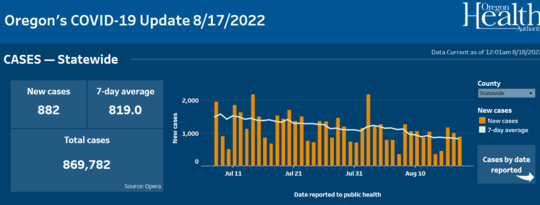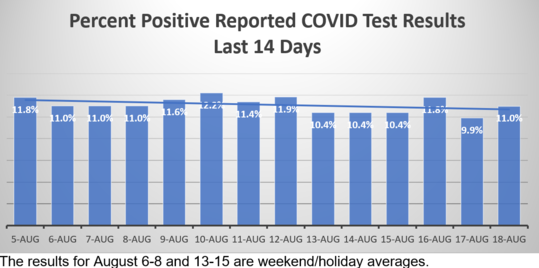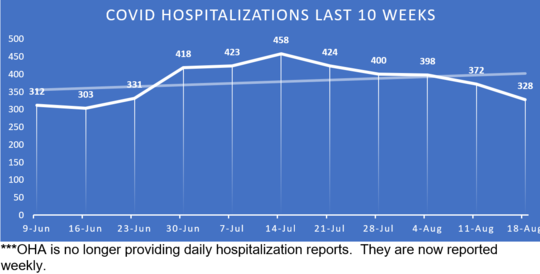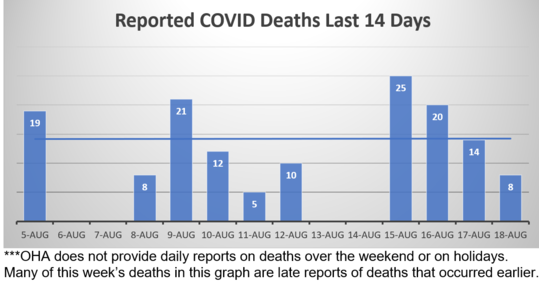|
August 21, 2022
Dear Neighbors and Friends,
I hope that you and your loved ones are doing well, staying healthy, and looking out for your neighbors and friends during this past week.
In this evening’s newsletter I’ll share the latest update from the Oregon Department of Forestry on the current wildfire situation in Oregon. We are definitely coming under pressure from lightning strikes, but so far the damage has been much less than we’ve become used to. Again this week, though, I must report another young firefighter lost in the line of duty.
On the COVID front, we’re continuing to see gradual improvements in nearly every county. Twenty of our 36 counties are now considered to be at Low Risk, and only two at High Risk. That’s the best it’s been for quite some time.
All the reported COVID metrics have continued to decline over the last week. Wastewater analysis shows sustained declines in Portland.
You’ll also find the latest forecast from OHSU in tonight’s newsletter. As you’ll see, it shows continuing declines over the next month or two—but then we must be prepared for potential increases.
You can read all the details below.
And a reminder about the Bike Town Hall on September 10!!!
Until next time, please do your best to stay healthy and safe. And let me know if you have any questions or thoughts about anything in this week’s newsletter.

This Week’s Fire Report
Legislators just received the latest update on wildfire in Oregon from the Chief of Protection at the Oregon Department of Forestry. As you’ll see, so far this has been a much easier summer than we’ve become used to. There have certainly been many lightning-generated fires already this summer, but they’ve been able to be contained pretty quickly without loss of homes.
That’s not to say that they have not been as dangerous as always. We lost another firefighter this week, this time an Oregonian from Talent, again as a result of a falling tree. You can read about this loss here.
And of course we must remember that we are now entering what has historically been the most dangerous time of fire season, when dry conditions, big winds, and thunderstorms coalesce to create enormous risk. Just remember what we experienced during Labor Day Weekend in 2020.
Here’s the report from Chief Shaw:
Good afternoon,
Over the last few days, thunderstorms with abundant lightning moved over the state, predominantly in southwest and central Oregon. ODF’s Southwest Oregon District alone was hit with 833 lightning strikes from Wednesday, August 17 to Friday, August 19. As a result of these lightning storms, several fires emerged which were grouped into two complexes.
The Westside Complex consists of 8 separate fires totaling approximately 175 acres. Of the fires within this complex, a few are of significance. These include the Tallowbox Fire, currently 26 acres and 100% lined, the Ladybug Gulch Fire, currently 80 acres and also 100% lined, and the Keeler Fire, which is approximately 60 acres and is expected to have a containment line around it by the end of the day today.
The Lightning Complex is comprised of nearly 50 individual fires and totals approximately 175 acres. Two significant fires within this complex, the Rum Creek Fire and the Hog Fire, will be managed by a Type 2 Interagency Incident Management Team beginning tomorrow. All remaining fires within the complex have control lines in place and are 100% contained within their perimeters. The combined firefighting efforts of all agencies since the lightning began is nothing short of phenomenal.
Severity aircraft continue to be critical to the fire fight as evidenced by the great stop in challenging conditions yesterday in ODF’s Central Oregon District. Lightning ignited the Big Canyon Fire late in the afternoon and ground crews were assisted by ODF’s two Fire Bosses (water dropping air tankers) and a Single Engine Air Tanker to keep the fire from entering the Three Rivers community south of Lake Billy Chinook. This was another great example of interagency cooperation and utilization of ground and air assets to protect life and property.
As safety continues to be the number one priority for firefighters as they engage in these fires, an unfortunate Line of Duty Death occurred on one of these fires. The firefighting community is extremely saddened by the tragic loss of Logan Taylor, a 25-year-old contract firefighter who was critically injured after being struck by a tree. Emergency personnel immediately deployed a helicopter to airlift Logan for transfer to the Asante Rogue Regional Medical Center where he ultimately succumbed to his injuries. This incident reminds us of the many risks involved in wildland firefighting. All agencies with a part in fighting fire have made it a point to reiterate to employees the risks that exist, and the mitigation measures required to keep similar incidents from happening. A joint jurisdiction investigation is also being conducted to identify opportunities to learn from this tragic event.
Current Statistics
For current fire season stats year to date on ODF protection, the chart below shows the agency remains well below the 10 year average on both number of fires and acres burned.
|
2022 Fire Season (01-01-2022 to 08-20-2022)
|
|
Cause
|
Fires
|
Acres
|
|
Lightning
|
96
|
449
|
|
Human (and UI)
|
355
|
262
|
|
Total
|
451
|
711
|
|
10 Year Average (2012–2021 Year to Date)
|
|
Lightning
|
210
|
49,171
|
|
Human (and UI)
|
520
|
25,180
|
|
Total
|
730
|
74,351
|
Fire Weather Forecast
Lightning is expected to taper off today before a new weather system pushes in tomorrow bringing thunderstorms and lightning, mainly over northeastern Oregon. This round of lightning is anticipated to last into Monday which appears likely to cause new fire starts in northeast Oregon. Winds, temperatures, and humidity will remain the same through Sunday east of the Cascades and drier conditions west of the Cascades. Warm and dry weather will continue into next week with elevated fire potential continues significant portions of Oregon.
Thank you for your continued partnership and support this fire season. I will provide another update on as conditions warrant.
Mike Shaw, Chief of Fire Protection
Again, here’s the ODF Wildfire Blog.
And again, I’d also recommend KOIN TV’s Wildfire Watch 2022.for ongoing information and stories. They’re doing a great job of covering the wildfire situation in the state.
ON THE COVID FRONT
Weekly Data Report:
Here is what this last week looks like in Oregon, based on information gleaned from OHA's daily reports. At the end of the newsletter you’ll find graphs that I’ve put together showing the daily counts and trends for the last two weeks.
Overall, all the chief COVID metrics--infections, test positivity, hospitalizations, and deaths have gone down in the last week, We appear to be in line with the latest OHSU forecasts, continuing on the downslope of the “Omicron COVID Crest.”
- The number of reported infections has dropped over the last week. OHA reported 5,743 new cases of COVID-19 during the week of August 5-11 (vs. 6,595 the week before), a 7-day average of 820 per day (vs 928 the previous week). The number of new cases is again likely an undercount, as many people are using home tests to determine their infection status but are not reporting those results.
- Average test positivity for the last week was 10.8%, down from the previous week’s 11.4%. Again, this number skews high because it likely reflects a higher proportion of people showing COVID symptoms (and thus going in for a test, rather than self-testing).
- On Wednesday there were 328 COVID-19-related hospitalizations statewide, vs. 372 last Thursday. Hospitalizations are now our best indicator of disease spread. Again, however, most of these hospitalizations are not in and of themselves due to COVID—more than half are those who tested positive after having been admitted for other reasons.
- The number of COVID patients in Oregon’s ICUs has gone down again over the last week: 38 on Thursday, down from last week’s 48. These are the most serious COVID infections.
- There were 77 COVID-19-related deaths reported during the last week, vs. 65 last week. Again, many deaths actually occurred in earlier weeks but were just reported to the state.
Weekly County Report: More than Half of Counties Now at Low Risk; Only Two at High Risk
According to the CDC Daily Counter (updated each Thursday), just 2 Oregon counties (down from 5 last week) are now at high risk of COVID transmission: Malheur and Morrow. The CDC assigns these risk levels based on a combination of the number of new COVID cases and the number of people in hospital for COVID.
Here’s what the CDC recommends for this category: Stay up to date with COVID-19 vaccines. Get tested if you have symptoms. Wear a mask if you have symptoms, a positive test, or exposure to someone with COVID-19. Wear a mask on public transportation. You may choose to wear a mask at any time as an additional precaution to protect yourself and others. If you are at high risk for severe illness, consider wearing a mask indoors in public and taking additional precautions.
Fourteen Oregon counties (up from 18) have reported infection rates that place them in the Medium Risk category: Baker, Coos, Crook, Curry, Deschutes, Harney, Jefferson, Klamath, Lake, Lincoln, Tillamook, Umatilla, Union, and Wallowa.
Twenty Oregon counties (up from 13)— Benton, Clackamas, Clatsop, Columbia, Crook, Douglas, Grant, Hood River, Jackson, Josephine, Lane, Linn, Marion, Multnomah, Polk, Sherman, Wasco, Washington, and Wheeler—are now at Low Risk.
We can also track the test positivity rates for each county at this dashboard. The test positivity rates reported this week show continued increases.
At 9.6%, Multnomah County shows a reduction from last week’s 10.9%. Washington County has gone up a little—9.3% vs. last week’s 8.9%. Clackamas County is back to being the lowest of the three Metro counties: 7.6% vs. 9.3% last week.

This Week’s Wastewater Monitoring Report Shows Continuing Stability in Oregon Cities
With testing reports giving us just a fraction of infections out there, wastewater monitoring has become a more reliable indicator of the amount of virus in cities around the state. That report is updated each week.
This week’s report shows us that two cities (up from 0 last week) are showing sustained increases: Corvallis and Stayton. Six (including Portland) are showing sustained decreases.
Of the cities monitored, 5% showed sustained increases (vs. 0% last week), 18% showed sustained decreases (vs. 3% last week), and 76% remained on a no-change plateau (vs. 95% last week).
OHA and ODE Press Conference—Updates and Plans
The Oregon Health Authority (OHA) and Oregon Department of Education (ODE) provided updates on Wednesday on the status of the COVID-19 pandemic and efforts to ensure Oregon schools can maintain in-person instruction during the 2022-2023 school year.
Dr. Dean Sidelinger, our state’s Public Health officer and State Epidemiologist, pointed out the significant declines in reported cases and hospitalizations that we’ve experienced since the last update (on July 20). These declines mirror what we’re seeing across the country right now.
Dr. Sidelinger did point to problems in the system, though. Hospitals are under a great deal of stress right now, a combination of people seeking long-delayed procedures and workers who are out because of illness and burnout. Also, hospitals are still having challenges finding longer-term skilled nursing facilities for patients who no longer need hospital-level care.
Dr. Sidelinger also provided a fall vaccine update. Pending federal and state approvals, he said, Oregon should expect to receive supplies of bivalent COVID-19 vaccine boosters this fall from both Pfizer and Moderna (perhaps as early as October). The bivalent vaccines have been designed to target BA.4 and BA.5 Omicron subvariants as well as the original strain.
He also encouraged everyone to get vaccinated for flu (a bad flu season is predicted for this year), ideally at the same time as they get the new booster.
He also encouraged parents to get their children vaccinated in advance of the coming school year. (Actually, school has already started in some parts of Eastern Oregon.) They have proven to be very safe for children, and children can receive their COVID vaccine at the same time that they receive other routine vaccines. The COVID vaccines remain—for now at least—free of charge for families.
Colt Gill, director of ODE, outlined what families and students can expect with COVID-19 planning and in-person instruction for the academic year. “As we head into the coming year, we are holding strong to our North Star goal of providing equitable access to in-person instruction all day, every school day, for every student,” said Gill.
Over the course of the last year, local school districts were able to take increasing control of decisions regarding COVID protocols. This coming year they will be able to make those decisions based on local conditions.
Gill also highlighted resources for K-12 schools available from ODE to prepare for the coming year. These include COVID-19 planning documents, the Care and Connection tools and Oregon Classroom WISE, a suite of free print and video resources, guided tutorials, role plays, and interviews with youth and school personnel to support the mental and emotional well-being of students and school staff.
Dr. Sidelinger also announced that Oregon has experienced its first case of pediatric Monkey Pox. He stressed that this is extremely rare. He didn’t feel that particular statewide protocols will need to be put in place at this time, though he encouraged parents to make sure they are not sending children with unknown rashes or lesions to school. Director Gill did add that schools are expected to have communicable-disease plans and protocols in place, and ODE will be sending out further information related specific to Monkey Pox.
In answer to a reporter’s question, Dr. Sidelinger said that OHA is looking forward to results of the newly-announced comprehensive self-review by the CDC.
He did remind us that we have to remain humble when we talk about COVID-19 and how it might change in the future. We can’t predict in advance what variants might arise and what kind of severity they will bring. The good news is that the vaccines and antiviral treatments are keeping people out of the hospital. He’s also looking forward to the potential benefits of the new Omicron-focused vaccines that should be available in the coming months.
Colt Gill echoed the need for districts to remain flexible and be prepared to respond to conditions as they come. Educators are excited at the prospect of starting a new year in a mode that’s more similar to what it was before COVID, but they also know they need to be prepared. Each district will have its COVID plan (including ventilation plans) posted on its website.
In response to another question, Dr. Sidelinger does not foresee vaccines being required of students in order to attend school. He also doesn’t anticipate a change in the masking requirement in healthcare settings.
Here are the talking points from today’s media availability. You can also watch it here.
OHSU Forecast: Downward COVID Slope Continues
The current OHSU Forecast Report, published on Thursday, uses data provided by OHA and others that project how fast the virus may spread in the population and provides projections on possible outcomes, including infection rates and impacts on hospital capacity. The lead author is Dr. Peter Graven, Director of OHSU’s Office of Advanced Analytics.
It now appears every two weeks.
This week’s report confirms that the recent surge has peaked and is continuing to recede. The forecast is largely unchanged from the last report.
- Cases continue to decline in Oregon. At 20 per 100k per day, Oregon has the 10th lowest case rate in the nation.
- As of Aug. 18, 292 people were in Oregon hospitals. This is a 38% drop from the peak of 464 reached on July 17th.
- Wastewater data continues to show declining viral levels.
- Visits to Oregon emergency rooms for COVID or COVID-like symptoms fell to 2.9% of all ER visits. The peak was 6.9% on July 9.
- Test positivity fell to 11.4%, continuing a decline.
- As of Aug. 16, 5% of occupied ICU beds had COVID patients in them statewide. This is down from 9% two weeks earlier.
- As of Aug. 14, six children were in Oregon hospitals with COVID, down from 12 two weeks before.
- The number of deaths per day has likely peaked.
- The current wave is expected to fall through September, with 129 people in hospitals on Sept. 21, before starting to climb again in October.
- While infections are expected to decline, standard waning of immunity is expected to generate a fall increase in infections. This may be mitigated by a vaccine booster. When the details of the vaccine become more clear the impact will be added to the model.
- The forecast is not based on a new variant but on generally waning immunity against existing strains. It also does not take any new vaccine or booster into account. The model can be adjusted as details emerge.
- South America, like Australia, has seen a strong flu season, highlighting the need for flu and COVID vaccines heading into fall.
- A CDC fall forecast is expected by the end of the month and will be shared in the next forecast.
Additional COVID Updates and Links







Here again are some COVID resources that you will find useful:
If the above links are not providing you with answers to your questions or directing you to the help that you need, please consider me and my office to be a resource. We’ll do our best to assist you or steer you in the right direction.
Want to See Past Newsletters?
If there was COVID-related information in a past newsletter that you want to go back to, but find you’ve deleted it, you can always go to my legislative website (senatordembrow.com), click on “News and Information,” and you’ll find them all there. Also, if someone forwarded you this newsletter and you’d like to get it directly, you can sign up for it there.
Best,
 Senator Michael Dembrow
District 23
email: Sen.MichaelDembrow@oregonlegislature.gov
web: www.senatordembrow.com
phone: 503-281-0608
mail: 900 Court St NE, S-407, Salem, OR, 97301
|